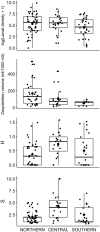Summer decapod crustacean larval communities along the eastern Spanish Mediterranean coast
- PMID: 36395266
- PMCID: PMC9671449
- DOI: 10.1371/journal.pone.0275892
Summer decapod crustacean larval communities along the eastern Spanish Mediterranean coast
Abstract
Decapod crustaceans are a diverse group englobing several species of commercial and ecological interest. In the Mediterranean Sea, decapod crustacean fisheries are among the most profitable, although in many cases their early life stages are poorly known. In this study, we tackle the composition and diversity patterns of the decapod larval communities along the eastern Spanish Mediterranean coast. Zooplankton sampling was carried out in surface waters at 101 stations from July 20th to August 31st 2016, over bottom depths between 90 and 1840 m. All shrimp larvae were identified to the lowest possible taxonomical level, and larvae from Anomura, Achelata and Brachyura were left at infraorder level. No larvae of Astacidea or Polychelida were found. The total zooplankton volume was estimated. A total of 20,022 decapod crustacean larvae were identified, focusing on shrimp taxa (suborder Dendrobranchiata and infraorder Caridea). Both zooplankton volume and decapod larval density values were higher in the northern part of the studied area, cut by deep submarine canyons. After assessing the diversity parameters of the decapod larval community, we present the summer mesoscale larval distribution of several species of commercial interest such as the caramote prawn (Penaeus kerathurus) or the deep-water rose shrimp (Parapenaeus longirostris). The northern submarine canyons are dominated by the presence of Penaeoidea, being the deep-sea shrimp Aristeus antennatus the dominant species in the community in this area, while the Sergestoidea are more abundant in the southern zone. This is the largest-scale study on decapod larvae mesoscale distribution in the Mediterranean Sea.
Copyright: © 2022 Carreton et al. This is an open access article distributed under the terms of the Creative Commons Attribution License, which permits unrestricted use, distribution, and reproduction in any medium, provided the original author and source are credited.
Conflict of interest statement
The authors have declared that no competing interests exist.
Figures







References
-
- Briones-Fourzán P.;Hendrickx M.E. Ecology and Diversity of Marine Decapod Crustaceans. Diversity 2022,14, 614. doi: 10.3390/d14080614 - DOI
-
- General Fisheries Commission for the Mediterranean (GFCM). (2020). The State of Mediterranean and Black Sea Fisheries 2020. The State of Mediterranean and Black Sea Fisheries 2020. doi: 10.4060/cb2429en - DOI
-
- Sardà F., Calafat A., Flexas M. M., Tselepides A., Canals M., Espino M., et al. (2004). An introduction to Mediterranean deep-sea biology. Scientia Marina, 68(SUPPL. 3), 7–38. doi: 10.3989/scimar.2004.68s37 - DOI
-
- Company J. B., Sardà F., Puig P., Cartes J. E., & Palanques A. (2003). Duration and timing of reproduction in decapod crustaceans of the NW Mediterranean continental margin: Is there a general pattern? Marine Ecology Progress Series, 261, 201–216. doi: 10.3354/meps261201 - DOI
-
- Sardà F., Demestre M. (1987). Estudio biológico de la gamba Aristeus antennatus (Risso 1816) en el Mar Catalán (NE de España). Investigaciones pesqueras 51 (Supl. 1), 213–232.
Publication types
MeSH terms
LinkOut - more resources
Full Text Sources

